Isabella Bradford's Blog, page 19
February 19, 2018
Pre-Victorians Becoming Posture Perfect
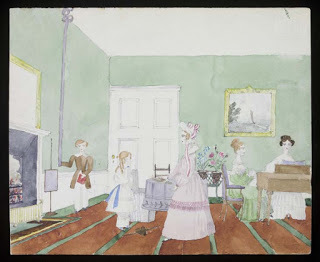 C.E. Drummond, Scene at Scotsbridge 1830
Loretta reports:
C.E. Drummond, Scene at Scotsbridge 1830
Loretta reports:“A horrible instrument was devised which I had to wear while doing my lessons. It was a steel rod which ran down my spine and was strapped at my waist and over my shoulders—another strap went around my forehead to the rod. I had to hold my book high when reading, and it was almost impossible to write in so uncomfortable a position. However, I probably owe my straight back to those many hours of discomfort.”—Consuelo Vanderbilt Balsan, The Glitter and the Gold
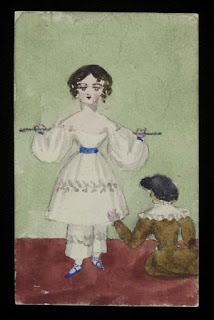 C.E. Drummond, watercolour drawing 1828-1830
C.E. Drummond, watercolour drawing 1828-1830
This sort of thing fit the late Victorian and Edwardian eras, when everything seems to have become so very strict: divisions between classes, excruciatingly complicated etiquette, and fashion.
But I had not thought about posture devices for the earlier period. After all, Susan and I are well aware that acutely straight posture was the order of the day in the 18th and 19th centuries. Women’s shoulder blades were supposed to come as close as possible to meeting in the back, and dress designs reflected this. The corset and especially the busk were all part of maintaining elegant posture.
Then, thanks to Susan's alerting me to an image, I bought and started reading Susan Lasdun’s Making Victorians: The Drummond Children’s World 1827-1832 . It has proved enlightening on a number of counts, not least the posture devices used on girls in the pre-Victorian era.
An especially poignant image, a watercolor by Cecile Elizabeth Drummond (at top), brought the point home forcibly—as it evidently did to the errant child. At her feet lies her backboard , which she’s apparently abandoned. And there is Mama, holding a birch rod—a bundle of twigs with which the little girl will be punished for her misbehavior.
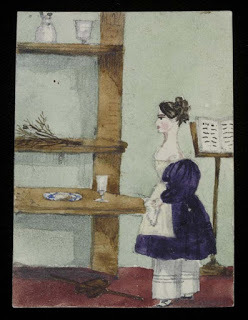 C.E. Drummond, watercolour drawing 1828-1830
C.E. Drummond, watercolour drawing 1828-1830
Lady Lasdun describes the backboard as a “painful” device, yet I’ve seen images of modern children wearing such backboards, in re-enactments ( here , here , and here , for example). If it truly were painful, would the re-enactment have been allowed? And would someone be selling them as " only suitable for use by children ."?
No doubt the backboard wasn’t comfortable—in the book are several images of children who’ve discarded their backboards and are anticipating a whipping—but it was probably less painful than the whipping, and certainly more comfortable than the iron monstrosity Consuelo Vanderbilt endured. Frankly, I suspect this sort of thing would have benefited my posture enough to compensate for the unpleasantness…though of course I wouldn’t have thought so at the time!
Images: watercolors by Cecil Elizabeth Drummond, 1828-30 (made); Prints, Drawings & Paintings Collection; Given by Miss Barbara Drummond, © Victoria and Albert Museum, London.
Clicking on the image will enlarge it. Clicking on the caption will take you to the source, where you can learn more and enlarge images as needed.
Published on February 19, 2018 21:30
February 18, 2018
Those Now-Famous Strands of George Washington's Hair: The Backstory
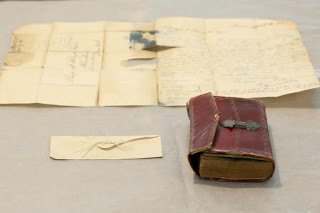 Susan reporting,
Susan reporting,If you're reading this blog, you're most likely a history nerd, and proud of it, too. It also likely means that somewhere you've read this week's favorite history story in the mainstream media: how a few strands of George Washington's hair were discovered tucked inside a 200-year-old almanac in the rare book library of Union College. Partly because it's almost Washington's birthday, and partly because it IS an interesting discovery, the story has been everywhere, including the Washington Post, The New York Times, USAToday, Newsweek, Newsday, US News & World Report, and the Smithsonian's SmartNews, NPR, and network and cable outlets as well. Last time I checked, it had appeared in over 200 outlets.
In many versions of these stories, I'm quoted (along with professors of history and hair-experts), describing how hair was a common memento among friends and family in the past. Which, of course, it was - but there's much more to the story than most journalists have space to tell. I don't have those constraints, and besides, I love all the nerdy-history details. There are even connections to Elizabeth Schuyler Hamilton, the heroine of my historical novel, I, Eliza Hamilton .
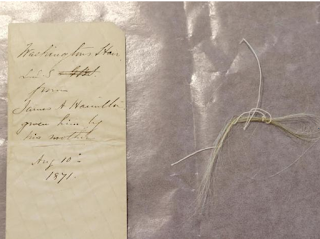
The almanac (shown above) - and the hair - were discovered during an inventory of the archival collections of Schaffer Library, Union College . Bound in red leather, Gaines Universal Register or American and British Kalendar for the year 1793 was a popular volume for gentlemen of the time, and contained useful, everyday knowledge such as population estimates for American cities and comparisons of various coins and monies. The almanac is inscribed "Philip Schuyler's a present from his friend Mr. Philip Ten Eycke New York April 20, 1793."
The first thought was that the almanac belonged to Gen. Philip Schuyler (1733-1804), a close friend of Gen. Washington who served under him during the American Revolution. Philip Schuyler was later active in Federalist politics and government as a U.S. senator from Albany, as well as one of the founders of Union College. He was also the father of Elizabeth Schuyler Hamilton (1757-1854), and father-in-law to Alexander Hamilton.
Tucked inside the almanac were several pages of handwritten notes and a business letter, which make the owner more likely General Schuyler's son, Philip Jeremiah Schuyler (1768-1835). Also inside the almanac was a slender yellowed envelope, upper right, with this written on one side: "Washington's hair, L.L.S. & (crossed out) GBS from James A. Hamilton given him by his mother, Aug.10, 1871." Inside the envelope were a few white hairs, tied together with a thread, left. Who were all these people, and could their identities help prove that the hair really had come from Washington?
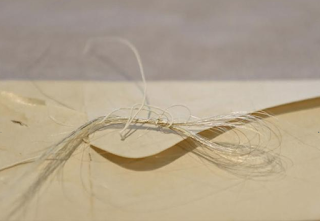
A Google search by Phillip Wajda, Union's director of media and public relations brought him to my blog pos t about historic hair in the collection of the Massachusetts Historical Society. (See the strands of Washington's hair, held together with red wax, that belong to MHS, lower right.) The handwriting accompanying that hair does appear to the be same as is on the envelope, belonging to James Alexander Hamilton (1788-1878.) James was the fourth child of Elizabeth and Alexander Hamilton, and, like his mother, was very aware of both his father's legacy and his family's place in American history.
Locks and strands of hair were often exchanged, especially as tokens of a deceased loved one. While it's impossible to be absolutely certain without DNA testing, the hair's provenance makes a strong case for it having come from Washington. The Hamiltons were close to the Washingtons, and it's likely that Martha shared George's hair with Elizabeth after George's death, if not before. It therefore makes sense that James passed along the hair given to him by his mother, Eliza, as he wrote on the envelope.
He gave the hair to family members who would have appreciated it, too. Thanks to the assistance of Jessie Serfilippi, an interpreter at the Schuyler Mansion in Albany, we determined that the initials refer to James's granddaughters, Louisa Lee Schuyler (1837-1926) and Georgina Schuyler (1841-1924.) The sisters continued the family interest in history through historic preservation - an idea growing in the late 19thc-early 20thc with a renewed appreciation for the country's early history. Together the sisters were instrumental in making Gen. Schuyler's grand colonial house in Albany into a New York historic site in 1917. At some point, the envelope with the hair must have been slipped into the almanac for safekeeping, forgotten, and then later donated to Union.
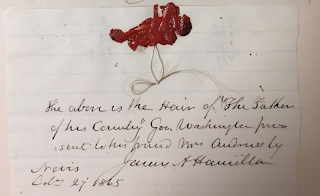
A digression into the complicated genealogy of Louisa and Georgina: Philip Jeremiah Schuyler (son of Gen. Schuyler, brother of Elizabeth Schuyler Hamilton, and owner of the almanac) and his second wife, Mary Anne Sawyer, had a son, George Lee Schuyler. George Lee Schuyler married his cousin Eliza Schuyler, the daughter of James Alexander Hamilton (son of Elizabeth and Alexander Hamilton.) George and Eliza became the parents of Louisa Lee and Georgia - who therefore were, through intermarriage, great-granddaughters to both Gen. Philip Schuyler and Alexander Hamilton. Whew!
What I find particularly fascinating about all this is that because Elizabeth Schuyler Hamilton lived to be 97, she would have known both Louisa Lee and Georgina as girls. Think of that: they would have heard first-hand stories of the American Revolution from Elizabeth, and yet they themselves lived into the 1920s. It's understandable that Louisa Lee and Georgina would have wanted the Schuyler Mansion to be preserved since they remembered their great-grandmother, who in turn would have remembered when the mansion (then her family's new home, known as The Pastures) was built in the 1760s.
Could there be any better backstory than that?
Thanks to Phillip Wajda, Jessie Serfilippi, and Anne E. Bentley, Curator of Art & Artifacts, Massachusetts Historical Society, for their assistance with this post.
Upper photos ©2018 Union College.
Lower right: Strands of hair belonging to George Washington, Massachusetts Historical Society, photo ©2017 Susan Holloway Scott.
Published on February 18, 2018 18:00
February 17, 2018
Breakfast Links: Week of February 12, 2018
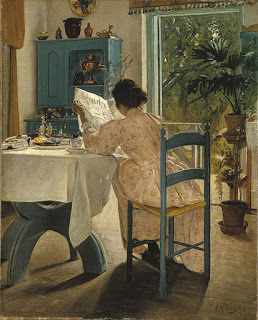 Breakfast Links are served - our weekly round-up of fav links to other web sites, articles, blogs, and images via Twitter.
Breakfast Links are served - our weekly round-up of fav links to other web sites, articles, blogs, and images via Twitter.• Archaeologists think this spinning disk - at least 14,000 years old - may have been a child's toy. More about ancient toys and children here .
• Tulipmania : the classic story of a 17thc Dutch financial bubble is mostly wrong.
• A grand piano bought by Queen Victoria as a gift to Prince Albert in 1854.
• The bloody world of Georgian female boxing .
• Filling in the 19thc history of pregnancy and dress .
• Image: Believed to be the earliest identified sampler by an African American, this rare work from 1793 carries a beautiful message.
• Queen Elizabeth I and Robert Dudley: the real story.
• The earliest photographs of the Henry Clay Frick mansion before it became an art museum.
• Image: A delicate mourning bonnet , c1870.
• The beautiful chaos of improvisational quilts : jazz with a needle.
• For author Mark Twain , it was love at first sight..
• Seven black nurses who changed medical history.
• Image: The contents of President Abraham Lincoln's pockets the night he was assassinated.
• Video: The only artifact in the collection of Fort Ticonderoga certain to have been used by a woman.
• Get your quills ready: a short guide to making a medieval manuscript .
• Now on-line: the commonplace books of Lady Augusta Murray , who married George III's son, the Duke of Sussex, and had his children, but then saw their marriage ruled invalid.
Hungry for more? Follow us on Twitter @2nerdyhistgirls for fresh updates daily.
Above: At Breakfast by Laurits Andersen Ring. Private collection
Published on February 17, 2018 14:00
February 15, 2018
A Marvelous Elephant Automaton, c1772
Susan reporting,
Everyone by now knows of the ongoing love affair that Loretta and I have for automata, those amazingly crafted and amazingly beautiful mechanized toys for their very wealthy. Somehow, I'd never come across this one before, and it's a stunner.
According to the information provided by Waddesdon Manor, the present owner of this automaton, this chased bronzed and bejeweled elephant was created in London around 1768-1772 by Hubert Martinet, described as a "businessman-entrepreneur" who likely oversaw a workshop of highly skilled French craftsmen. Many such automata were intended as gifts for Indian officials and rulers as part of the complicated trading protocol of the French and English East India Companies. For whatever reason, however, this elephant - glittering with gilt and paste jewels - was never sold for that purpose. Instead it was widely exhibited in London, Paris, and the Netherlands, passing through several owners. It was finally purchased by Baron Ferdinand de Rothschild sometime before 1889, and added to his collection of treasures at Waddesdon.
Musical automaton, signed Hubert Martinet, 1768-1772, Waddesdon Manor.
If you receive this post by email, you may be seeing only a blank spot or black box where the video should be. Please click here to view the video.
Published on February 15, 2018 21:00
February 14, 2018
Thames Watermen & Their Wherries
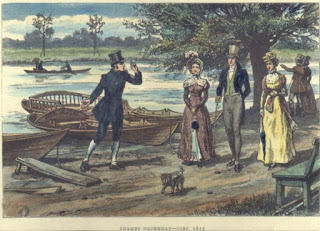 Thames Waterman—circa 1825
Loretta reports:
Thames Waterman—circa 1825
Loretta reports:By 1833, the time of A Duke in Shining Armor , it would have been simple enough for my hero and heroine to get on a steamboat to continue upriver from Battersea Bridge. I decided to put them on a wherry instead. The chances of mishap on either vessel were good: Steamboats exploded, and wherries overturned or lost passengers overboard. And of course, I’m always looking for ways to make my characters’ lives difficult.
The wherries, about which I knew next to nothing, however, were aesthetically pleasing, and turned out to have a long history, while the watermen had a distinctive character.
“As may easily be imagined, they formed very much of a caste by themselves… They were a rough, saucy, and independent lot, if we may judge from allusions to them which occur in the novels, comedies, farces, and popular songs of the last century.” —Old and New London Vol 3
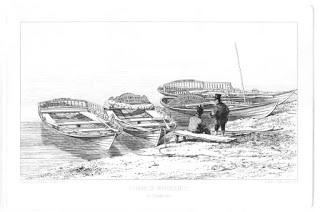 Thames Wherries, Richmond 1829
As to their vessels:
Thames Wherries, Richmond 1829
As to their vessels:Thames Wherries.—Of all wherries in the world, none are so beautifully modelled or so light and graceful as the "trim-built wherries" of the Thames. They are constructed upon the most scientific and approved lines; the numerous boatbuilders daily endeavouring to outvie each other. These boats are truly a pattern for all nations, and are the especial admiration of foreigners, particularly the smaller craft, adapted for a party of five or six. They have a beautiful sharp bow, with graceful proportions, carrying the beam well aft, or gradually flaring from the bows, and finishing with a neat tapering stern: a chair rail, for a support to the back, is prettily arranged round the stern-sheets, where the company sit. —H.C. Folkard, Esq., The Sailing Boat 1863 3rd ed
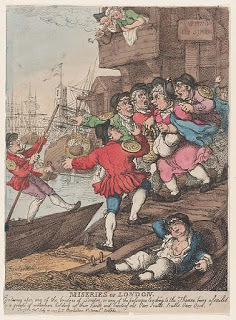 Rowlandson, Thames Watermen 1807
Though I found
images of wherries with a top covering
, like the one described in the book, only recently did I come upon the term for these boats: “By a 'tilt' boat of course is meant a boat with a covering." —Old and New London Vol 3. Or, as the OED describes it: "tilt-boat n. [SE tilt-boat,] ‘a large rowing boat having a tilt or awning, formerly used on the Thames, esp. as a passenger boat between London and Gravesend."
Rowlandson, Thames Watermen 1807
Though I found
images of wherries with a top covering
, like the one described in the book, only recently did I come upon the term for these boats: “By a 'tilt' boat of course is meant a boat with a covering." —Old and New London Vol 3. Or, as the OED describes it: "tilt-boat n. [SE tilt-boat,] ‘a large rowing boat having a tilt or awning, formerly used on the Thames, esp. as a passenger boat between London and Gravesend." Clicking on the image will enlarge it. Clicking on the caption will take you to the source, where you can learn more and enlarge images as needed.
Published on February 14, 2018 21:30
February 12, 2018
Hamilton vs. Burr: The Most Infamous Duel in American History, 1804
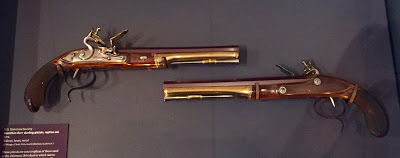
Susan reporting,
Loretta and I have been friends forever, and between us we've written a LOT of books. Over the years, there's been much commiseration over characters that don't behave, or plots that are hopelessly knotted, or cover art that's just so not what we'd imagined. But we had a first with our two current books: we both wrote stories with duels. (See Loretta's post about dueling pistols here , and a Friday Video about firing 19thc pistols here .)
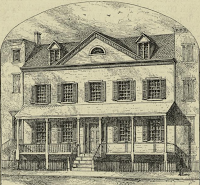
Since my book - I, Eliza Hamilton - is a historical novel based on the life of the life of the wife of Alexander Hamilton, I don't think it's a spoiler to say that the duel in my story doesn't end happily for my protagonists. Early on the morning of July 11, 1804, Hamilton had himself rowed across the Hudson River to Weehawken, NJ for an "interview", the term for the arranged time for two gentlemen to meet for a duel, with Aaron Burr. (For the background to the duel and its aftermath, see Affairs of Honor: National Politics in the New Republic by Joanne B. Freeman. Wonderfully detailed and readable, this is the same book that Lin-Manuel Miranda consulted while he was writing Hamilton: An American Musical.)
Following the conventions of the day, their seconds turned their backs to keep from being witnesses, and as a result, no one is entirely certain of what happened when the two pistols fired. Most believe that Hamilton intentionally fired into the air, satisfying the demands of honor, but keeping to his beliefs as a Christian by not taking another man's life. Burr, however, shot with purpose, severely wounding Hamilton. Partially paralyzed, bleeding profusely, and drifting in and out of consciousness, Hamilton was taken back to Manhattan to the house of Nicholas Bayard, upper right, where he died the following afternoon, surrounded by his grief-stricken family and friends. In addition to his widow Elizabeth Schuyler Hamilton, he left behind seven children, the youngest still an infant. Less than three years earlier, the Hamiltons' eldest son, Philip, aged 19, had also been killed in a duel defending his father's honor - possibly with the same pistols.
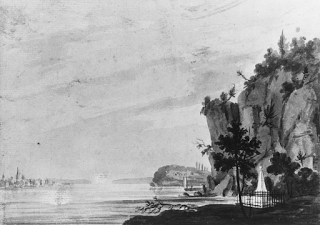
Even in an era long before social media, word of the duel spread swiftly, and by noon all of New York knew of it. The shock, outrage, and sorrow following Hamilton's death were immediate. he had been a popular man in the city he'd made his hometown, and the tragedy of his death plunged New York into deep mourning.
Burr, meanwhile, had fled to avoid being charge with murder. Although he had followed the rules of dueling, Burr was reviled for killing Hamilton, and while the murder charges were eventually dismissed, his life, fortunes, and reputation never recovered.
The entire country was stunned. How could the current vice president of the United States and the former Secretary of the Treasury - both respected gentlemen, lawyers, and veterans from the Revolutionary War - engage in a fatal duel for the sake of honor? The practice was deplored and defended, sermons thundered from pulpits, and the sight of Eliza shrouded in mourning with her fatherless children touched everyone who glimpsed it. Over two hundred years later, the Hamilton-Burr duel remains the most famous/infamous duel in American history, and likely the only one most modern Americans can name.
Within a year of Hamilton's death, a marble monument in his honor had been placed at the site of the duel at Weekhawken, left. Before long, souvenir-seekers had chipped away so many pieces of the marble that the monument was finally taken down around 1820, and later in the century the original dueling grounds were obliterated by railroad construction. Only the pitted marble plaque from the monument's base, lower right, now remains in the New-York Historical Society. Today the duel is commemorated in Weekhawken with a small park at the top of the Palisades overlooking the original site. The park includes a bust statue of Hamilton, the stone where he was traditionally believed to have rested against after being wounded, and a stunning view of the Manhattan skyline. It's become such a popular site for visitors that it now has it has a page on TripAdvisor .
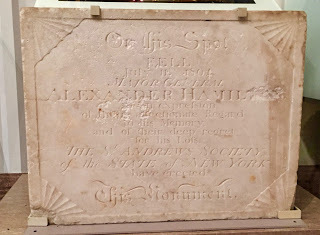
The New-York Historical Society also owns exact replicas of the pistols used in the duel, above. The original 18thc pistols were made by the noted gunsmith Robert Wogdon in London, and belonged to Hamilton's brother-in-law, John Barker Church. The original pistols still exist, and are now in the headquarters of J.P. Morgan & Chase Company. This modern bank is the descendant of The Manhattan Company, founded by Burr in 1799 as a water service company - and something of a scam, since the water company quickly evolved into a bank to rival the Bank of New York, founded earlier by Hamilton.
Have I seen the original pistols? No; I haven't the heart (but you, who are of sterner stuff, can see a photo of them here ). Seeing the replicas and realizing exactly how large the ball must have been to fit those barrels - and imagining the damage such a ball would cause - was enough for me.
And yes, when I wrote the scene with the aftermath of that duel through Eliza Hamilton's eyes, I cried.
Top: Hamilton-Burr Dueling Pistols, replica set, 1976, New-York Historical Society. Photo ©2017 Susan Holloway Scott.
Upper right: Bayard House (Where Hamilton Died), 1892, New York Public Library.
Middle left: The Monument to Alexander Hamilton by Pavel Petrovich Svinin, c1811-1813, Metropolitan Museum of Art. (black and white reproduction)
Lower right: Location Where Alexander Hamilton was wounded, maker unknown, 1805, New-York Historical Society. Photo ©2017 Susan Holloway Scott
Published on February 12, 2018 20:33
February 11, 2018
Rediscovering an American Community of Color in Worcester
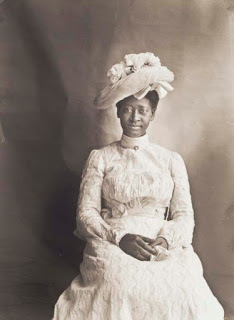 Martha (Patsy) Perkins, 1901
Loretta reports:
Martha (Patsy) Perkins, 1901
Loretta reports:A little over a hundred years ago, a white photographer took hundreds of pictures of people in central Massachusetts. Among these were more than 230 portraits of people of color who lived within easy walking distance of my home. I had no idea this community existed until I went to see Rediscovering an American Community of Color: The Photographs of William Bullard at the Worcester Art Museum.
There are several amazing things about this exhibition. First, the glass negatives survived for over a century and ended in the hands of a collector who was also a devoted Worcester historian.* Second, the photographer’s logbook also survived, and stayed with the photographs. Third, thanks to his granddaughter’s making the connection between tiny numbers on the negatives and the logbook, it became possible to identify the people in the photographs. Thus, the Clark University students who researched the photographs were able to contact many of their subjects’ descendants. Also, during my third visit to the exhibition (yes, it’s that good, that moving), I got to meet one of those descendants.
The Beaver Brook neighborhood became a new home when the Ku Klux Klan and white backlash, combined with a national depression and the end of Reconstruction, destroyed the lives that former slaves had been making for themselves in the South. They came north, and some came to Worcester, “a city with a deep abolitionist tradition and influential white residents sympathetic to their plight.”**
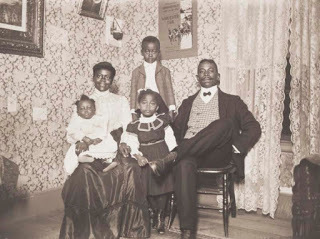 Thomas A. and Margaret Dillon Family, about 1904
Thomas A. and Margaret Dillon Family, about 1904
Since it’s impossible to do the show justice in a blog post, I offer links.
The Worcester Art Museum page on the Bullard exhibition includes several reviews well worth reading as well as a short YouTube video.
This exhibition runs until 25 February—only a few more weeks. However, thanks to Clark University’s collaboration with the museum, we can see many of the images at the website, Rediscovering an American Community of Color: The Photographs of William Bullard, 1897-1917 .
There you’ll find not only a gallery of the photos , but also a page about the collection and the photographer , a map of the neighborhood in 1911 , essays connected to the images, and a chance to add information and/or comment on individual photos.
I also highly recommend the beautiful exhibition catalog .
*Frank J. Morrill, a retired history teacher and collector, and definitely and delightfully a Nerdy History Person.
**quote from exhibition catalog.
Images: William Bullard, Martha (Patsy) Perkins, 1901 and Thomas A. and Margaret Dillon Family, about 1904 , courtesy of Frank Morrill, Clark University and Worcester Art Museum.
Clicking on the image will enlarge it. Clicking on the caption will take you to the source, where you can learn more and enlarge images as needed.
Published on February 11, 2018 21:30
February 10, 2018
Breakfast Links: Week of February 5, 2018
 Breakfast Links are served - our weekly round-up of fav links to other web sites, articles, blogs, and images via Twitter.
Breakfast Links are served - our weekly round-up of fav links to other web sites, articles, blogs, and images via Twitter.• Illustrating carnival: exploring the fantastic, forgotten artists of early Mardi Gras in New Orleans.
• Wonders of the hidden edge: fore-edge paintings from the New-York historical society, here and here .
• Beyond the slave trade: the little-known trade in slave cadavers .
• Women that conquered the world of comics .
• Image: A stunning pair of women's tall bespoke boots , 1890s.
• Don Pedro , the last true pirate to raid the Atlantic Sea - in 1832.
• So which city was first called the " Cradle of Liberty "?
• "The hall is enormous....3,700 people!" Charles Dickens wrote this letter to his wife Catherine in 1854 about his popular reading tours.
• The remarkably beautiful carpet pages from the Lindisfarne Gospels , c700.
• Image: The colors of the women's suffrage movement - purple, green, and white - appeared in everything from brooches to banners.
• How to have a 18th-19thc historically accurate lovers' tiff .
• The invention and importance of the overlock sewing machine (serger.)
• Nerdy History Girl goals: to visit England's historic hotel network .
• Image: An American Merchant Tours Yokohama, 1861.
• The humble apron of the 18th century.
• Introduced in 1945, and " designed for generations of use ."
• Where the Dickens (hint, hint) did that word come from?
• Sheer beauty of nature: video of manta rays who leap balletically from the water nine feet into the air.
Hungry for more? Follow us on Twitter @2nerdyhistgirls for fresh updates daily.
Above: At Breakfast by Laurits Andersen Ring. Private collection
Published on February 10, 2018 14:00
February 8, 2018
Friday Video: Dueling Pistols in Real Life
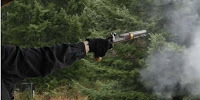 Loretta reports:
Loretta reports:As promised, today we have some video dealing with early 19th-century pistols.
You might want to watch “ A brief introduction to the rules of historical pistol duels ” as well, though I ask you to bear in mind that the Code Duello was not followed by everybody everywhere. For the duel in A Duke in Shining Armor , I referred to The Art of Duelling (1836), whose rules are different. This same gun aficionado simulates a duel here . This and today's official video make it clear how difficult it was to shoot accurately, even with the finest pistols and lots of practice. In short, in my story I did take liberties regarding the level of accuracy generally possible.
Though the video doesn't show the loading process in quite as much detail as this Nerdy History Girl could wish, Sklar does give an idea of what was involved in loading a pistol, while his examination of the gun offers a clue to how many things could go wrong—as The Art of Duelling emphasizes.
Video: Showing and firing an antique percussion pistol (Aston 1842)
Image at top is a still from the video. Readers who receive our blog via email might see a rectangle, square, or nothing where the video ought to be. To watch the video, please click on the title to this post or the title of the video.
Published on February 08, 2018 21:30
February 7, 2018
Dueling Pistols and How They Work
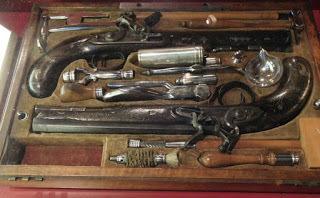 Loretta reports:
Loretta reports:A duel figures prominently in A Duke in Shining Armor . I’ve posted about dueling practices ( here and here ), and will again. Today, though, I thought you might want to take a look at some actual weapons.
The elaborately fitted-out case from the Museum of London features a pair of Flintlock Dueling Pistols of about 1810. (By the time of my story, the men would be using percussion lock pistols. However, the conversion didn’t demand a whole redesign of the pistol. Many flintlocks were easily converted to percussion, as you will discover if you click on the links above.)
According to the entry on the museum website :
“In the case with these pistols are the necessary accessories for cleaning and loading them. These include a brush, a powder flask, a ram rod, a bullet mould and a ladle for pouring the molten lead to make the bullets…The barrels of the pistols are double-stamped with the mark of two crossed sceptres beneath a crown. This records that they were made privately and proofed (test-fired) at the Board of Ordnance proofing house in the Tower of London. The pistols are fitted with rain-proof flash pans, an innovation that kept the powder dry in bad weather. The name on the lockplate 'Toms' is likely to be an engraving error. The pistols were probably made by William Tomes, a gunsmith with a workshop on Whitechapel Road. Tomes was a military contractor who supplied guns to the East India Company."
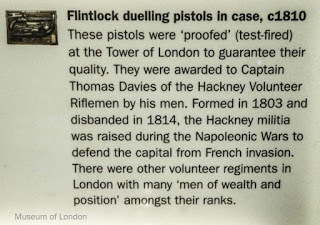
In my investigations online, however, most of the cases are a little simpler. Preparing, loading, and firing a a gun in the early 1800s was, however, a complicated business. But a video is worth thousands of words: Please watch for a demonstration on Friday's video.
Readers of Georgette Heyer, not to mention numerous other Regency-era authors, will have come upon the name Manton. You can get several close-up views of a Regency era pair of these highly regarded dueling pistols here .
Photographs copyright 2018 Walter M. Henritze III.
Published on February 07, 2018 21:30



